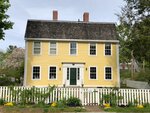

The pretty yellow house just before the bridge on Harbor Street was built in 1771. In 1725 the land belonged to shoreman Nathaniel Marsters. His family is traced back in town to the early 1650s. Nathaniel granted the town a path past his house to what we know as Tuck’s Point. When Nathaniel died in 1738 his will and deed referred to a much smaller house, a barn, and farm animals, clapboards, shingles, and nails. Nathaniel was considered a “gentleman” and left a small fortune to his wife, Hannah. She repaired the house and barn but continued to live with her 9 children in that small house.
Hannah’s 1760 will called for the property to be divided among her children. When she died in 1771, however, the house and “133 poles of land” were not divided among the siblings but were awarded to the oldest son, Andrew. He paid his siblings their share, 178.59 shillings each. He became a wealthy mariner and trader and built what was known at the time as the “mansion” house. By 1774 Andrew was a selectman and became a captain of the Manchester militia.
Marsters was a member of the Committee of Correspondence and raised money for the town militia. In April 1775 he led the Manchester militia on a march toward Lexington. When he died in 1780, his daughter, Anna, and her husband, Benjamin Epes, lived in the house until 1785 when they sold it to William Tuck, Esquire, mariner, and famed Revolutionary War privateer. Not only was Tuck active in town politics and a staunch Federalist but he was also appointed a federal customs officer by President Washington.
Squire Tuck died in 1826 and left the property to his wife, Molly, but the estate had debts and was auctioned in 1828 and purchased by other family members. Asa Osborne, married to William Tuck’s daughter, Lydia, lived in the house more than 20 years. The Osborne’s daughter, Lydia, lived in Boston by 1900 and rented the house to George Whipple who then bought the house in 1923. The house had been owned by a Tuck since 1785. Upon the death of Mr. Whipple, the property went to the Society for the Preservation of New England Antiquities. It is now under a preservation easement with Historic New England. The current owner, Marianthe Mewkill, is the conscientious steward of this special property.